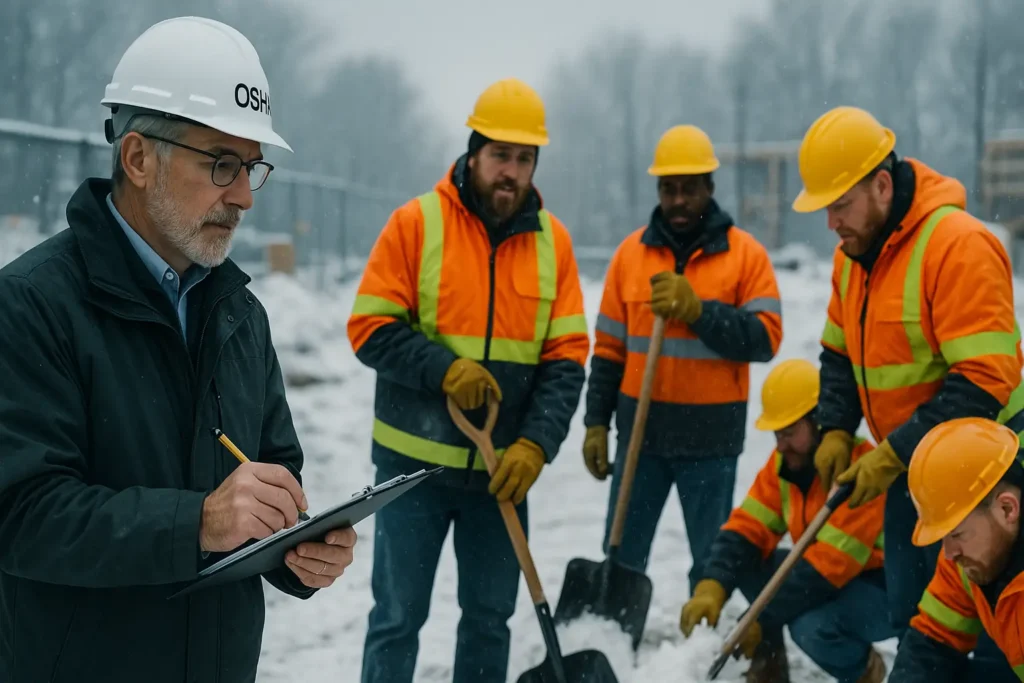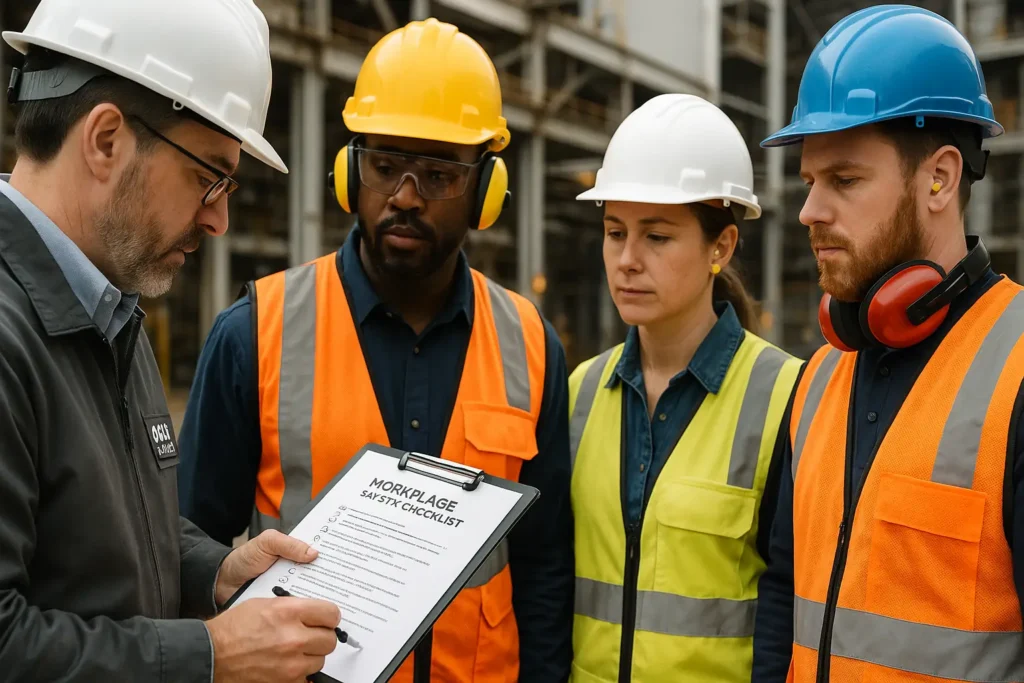Top 10 Hazards OSHA Inspectors Look for at Work
The Occupational Safety and Health Administration (OSHA) plays a critical role in enforcing workplace safety standards across the United States. Through inspections, OSHA identifies hazards that put employees at risk and ensures employers are meeting compliance requirements. Inspections are often triggered by accidents, complaints, or high-risk industry conditions, but they can also be random. Understanding what OSHA inspectors look for allows employers to proactively address issues before they become violations. For workers, hazard awareness is equally important, as it helps prevent injuries and promotes a safer, more productive workplace.
Top 10 Hazards OSHA Inspectors Look for
OSHA inspections often reveal recurring workplace risks that threaten employee safety. Understanding these top hazards helps employers stay compliant and protect workers from preventable injuries.
1. Machine and Motion Hazards
Workplaces with moving machinery and equipment pose some of the most serious risks during an OSHA inspection. Rotating parts, conveyors, and mechanical components can easily cause severe injuries if not properly guarded or maintained. Without adequate training and safeguards, workers may face entanglement, amputations, or caught-in/between incidents that lead to life-altering consequences.
Key concerns include:
- Unprotected moving parts on machines
- Lack of lockout/tagout procedures
- Loose clothing or hair near rotating equipment
- Missing or damaged machine guards
2. High Temperature Hazards
High heat environments, whether from hot surfaces, steam, or heated machinery, present multiple dangers to workers. Beyond the risk of direct burns, prolonged exposure can lead to heat stress, dehydration, or even fires in extreme cases. OSHA inspections pay close attention to how workplaces control these hazards and protect workers from unsafe exposure.
Key concerns include:
- Hot pipes, surfaces, and equipment without insulation
- Steam leaks or poorly maintained boilers
- Inadequate ventilation in high-temperature areas
- Lack of PPE, such as heat-resistant gloves or clothing
3. Sharp and Cutting Hazards
Workplaces that use blades, cutting tools, sheet metal, or equipment with sharp edges present a high risk of injury. Even routine tasks like trimming, slicing, or handling materials can cause lacerations, punctures, or eye damage if safety precautions are ignored. OSHA inspectors focus on whether protective measures and proper handling procedures are in place to minimize these risks.
Key concerns include:
- Exposed blades or poorly maintained cutting tools
- Lack of protective gloves or eye protection
- Improper storage of sharp materials
- Inadequate training on tool handling and safety
4. Rolling and Crushing Hazards
Heavy equipment, forklifts, and falling loads create significant rolling and crushing dangers on worksites. These hazards often result in “struck-by” or “caught-between” incidents, which are among OSHA’s top safety concerns. Employers must ensure safe equipment operation and load handling to protect workers from serious or fatal injuries.
Key concerns include:
- Workers positioned near moving forklifts or vehicles
- Improperly stacked or secured loads
- Poor visibility in busy work areas
- Lack of protective barriers in high-traffic zones
5. Electrical Hazards
Electrical systems, wiring, and powered equipment can pose serious risks if not properly maintained. Exposed wires, overloaded circuits, or faulty tools increase the chance of shocks, burns, or electrocution. OSHA inspectors often check whether lockout/tagout procedures and protective equipment are in place to reduce risks.
Key concerns include:
- Exposed or damaged electrical wiring
- Lack of ground-fault circuit interrupters (GFCIs)
- Improper lockout/tagout practices during maintenance
- Use of damaged cords, plugs, or tools
6. Chemical and Hazardous Substance Hazards
Many workplaces use chemicals, solvents, and cleaning agents that can harm workers if handled incorrectly. Exposure may lead to burns, respiratory issues, or long-term illnesses. OSHA inspections focus on hazard communication, proper labeling, and employee training under the HazCom Standard.
Key concerns include:
- Missing or unclear Safety Data Sheets (SDS)
- Improper labeling of chemical containers
- Lack of protective gear like gloves, masks, or goggles
- Inadequate training on safe chemical handling
7. Slips, Trips, and Fall Hazards
Slips, trips, and falls are among the most common workplace accidents, often resulting from poor housekeeping, wet floors, or cluttered walkways. Falls from height, such as ladders or scaffolds, can lead to severe injuries or fatalities. OSHA inspectors look closely at fall protection systems and housekeeping practices.
Key concerns include:
- Wet or uneven walking surfaces
- Unsecured ladders or scaffolding
- Missing guardrails on elevated platforms
- Obstructed or poorly lit walkways
8. Noise Hazards
Excessive workplace noise can cause permanent hearing loss and increase stress levels if not controlled. OSHA sets limits for permissible noise exposure and requires employers to provide hearing protection when those limits are exceeded. Inspections often check for monitoring, protective gear, and training.
Key concerns include:
- Prolonged exposure to high-decibel machinery
- Lack of hearing conservation programs
- Missing or inadequate ear protection
- Failure to monitor and document noise levels
9. Electrical Hazards
Electrical risks are a major focus during OSHA inspections, as they can cause shocks, burns, fires, or electrocution. These hazards often stem from faulty wiring, exposed conductors, or improper lockout/tagout practices. Inspectors pay close attention to electrical panels, equipment grounding, and worker training.
Key concerns include:
- Exposed live wires or damaged cords
- Overloaded circuits and improper use of extension cords
- Missing lockout/tagout procedures during maintenance
- Lack of training in electrical safety practices
10. Chemical and Hazardous Material Hazards
Workers handling chemicals face risks such as burns, poisoning, respiratory issues, and explosions. OSHA requires compliance with the Hazard Communication Standard (HazCom), ensuring workers know about chemical dangers and how to protect themselves. Inspectors often check labeling, storage, and employee training.
Key concerns include:
- Improper labeling of hazardous substances
- Poor storage of flammable or toxic materials
- Missing or incomplete Safety Data Sheets (SDS)
- Lack of personal protective equipment (PPE) for chemical handling
Wrap Up
OSHA inspections highlight the most common and preventable hazards that put workers at risk. From machine motion and high temperatures to chemical exposure and electrical dangers, these risks can lead to serious injuries if ignored. Employers who stay proactive with regular training, hazard assessments, and proper safety controls not only avoid costly violations but also foster a safer, more productive workplace.
Stay OSHA-Ready!
Enroll your team in OSHA 10-Hour or 30-Hour Online Construction or General Industry Training to strengthen adherence and safety culture.
Get Started →Related Posts

Training on a Budget? Find OSHA Training at a Low Price

OSHA Winter Safety Tips for 2025: Protect Outdoor Workers


